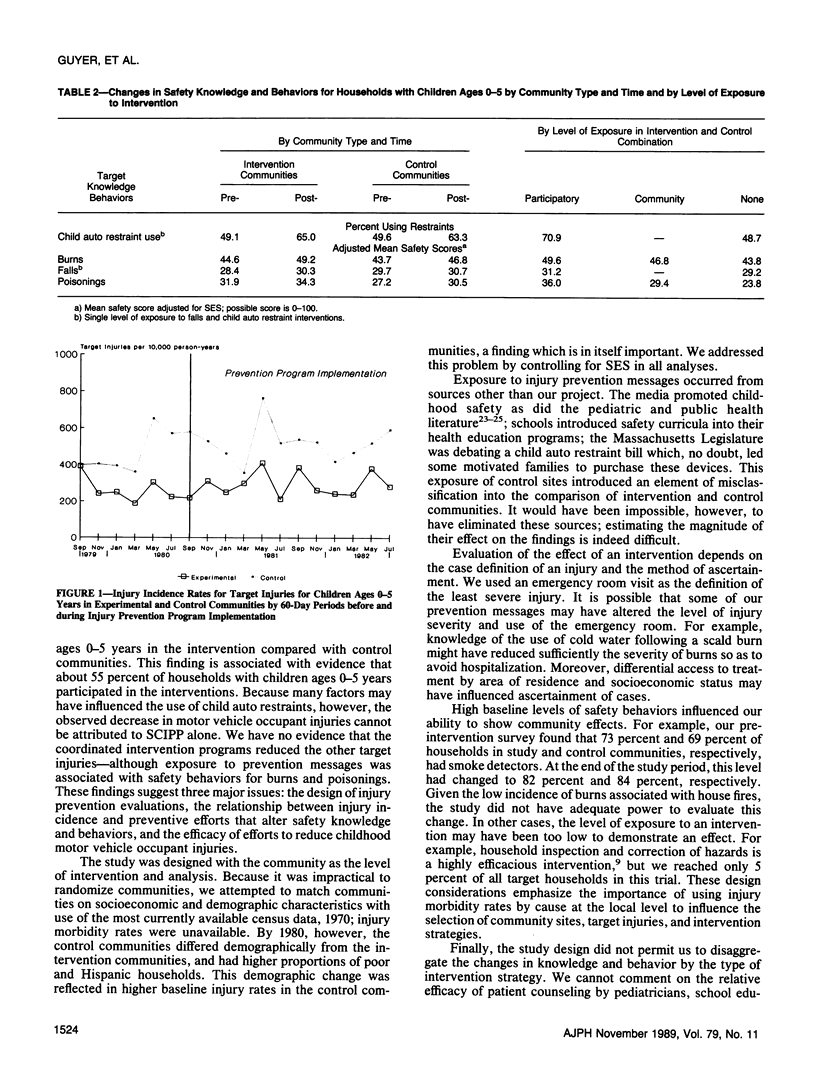Abstract
We evaluated the effectiveness of a community-based injury prevention program designed to reduce the incidence of burns, falls in the home, motor vehicle occupant injuries, and poisonings and suffocations among children ages 0-5 years. Between September 1980 and June 1982, we implemented five injury prevention projects concurrently in nine Massachusetts cities and town; five sites, matched on selected demographic characteristics, were control communities. An estimated 42 percent of households with children ages 0-5 years were exposed to one or more of the interventions over the two-year period in the nine communities. Participation in safety programs increased three-fold in the intervention communities and two-fold in the control communities. Safety knowledge and practices increased in both intervention and control communities. Households that reported participatory exposure to the interventions had higher safety knowledge and behavior scores than those that received other community exposure or no exposure to intervention activities. We found a distinct reduction in motor vehicle occupant injuries among children ages 0-5 years in the intervention compared with control communities, associated with participatory exposure of about 55 percent of households with children ages 0-5 years. We have no evidence that the coordinated intervention programs reduced the other target injuries--although exposure to prevention messages was associated with safety behaviors for burns and poisonings.
Full text
PDF






Selected References
These references are in PubMed. This may not be the complete list of references from this article.
- Bass J. L., Mehta K. A., Ostrovsky M., Halperin S. F. Educating parents about injury prevention. Pediatr Clin North Am. 1985 Feb;32(1):233–242. doi: 10.1016/s0031-3955(16)34770-8. [DOI] [PubMed] [Google Scholar]
- Farquhar J. W., Fortmann S. P., Maccoby N., Haskell W. L., Williams P. T., Flora J. A., Taylor C. B., Brown B. W., Jr, Solomon D. S., Hulley S. B. The Stanford Five-City Project: design and methods. Am J Epidemiol. 1985 Aug;122(2):323–334. doi: 10.1093/oxfordjournals.aje.a114104. [DOI] [PubMed] [Google Scholar]
- Gallagher S. S., Finison K., Guyer B., Goodenough S. The incidence of injuries among 87,000 Massachusetts children and adolescents: results of the 1980-81 Statewide Childhood Injury Prevention Program Surveillance System. Am J Public Health. 1984 Dec;74(12):1340–1347. doi: 10.2105/ajph.74.12.1340. [DOI] [PMC free article] [PubMed] [Google Scholar]
- Gallagher S. S., Hunter P., Guyer B. A home injury prevention program for children. Pediatr Clin North Am. 1985 Feb;32(1):95–112. doi: 10.1016/s0031-3955(16)34759-9. [DOI] [PubMed] [Google Scholar]
- Green L. W. Manual for scoring socioeconomic status for research on health behavior. Public Health Rep. 1970 Sep;85(9):815–827. [PMC free article] [PubMed] [Google Scholar]
- Lovejoy F. H., Jr, Caplan D. L., Rowland T., Fazen L. A statewide plan for care of the poisoned patient: the Massachusetts Poison Control System. N Engl J Med. 1979 Feb 15;300(7):363–365. doi: 10.1056/NEJM197902153000712. [DOI] [PubMed] [Google Scholar]
- MacKay A. M., Rothman K. J. The incidence and severity of burn injuries following Project Burn Prevention. Am J Public Health. 1982 Mar;72(3):248–252. doi: 10.2105/ajph.72.3.248. [DOI] [PMC free article] [PubMed] [Google Scholar]
- McLoughlin E., Vince C. J., Lee A. M., Crawford J. D. Project Burn Prevention: outcome and implications. Am J Public Health. 1982 Mar;72(3):241–247. doi: 10.2105/ajph.72.3.241. [DOI] [PMC free article] [PubMed] [Google Scholar]
- Miller R. E., Reisinger K. S., Blatter M. M., Wucher F. Pediatric counseling and subsequent use of smoke detectors. Am J Public Health. 1982 Apr;72(4):392–393. doi: 10.2105/ajph.72.4.392. [DOI] [PMC free article] [PubMed] [Google Scholar]
- Puska P., Nissinen A., Salonen J. T., Toumilehto J. Ten years of the North Karelia Project: results with community-based prevention of coronary heart disease. Scand J Soc Med. 1983;11(3):65–68. [PubMed] [Google Scholar]
- Reisinger K. S., Bires J. A. Anticipatory guidance in pediatric practice. Pediatrics. 1980 Dec;66(6):889–892. [PubMed] [Google Scholar]
- Reisinger K. S., Williams A. F., Wells J. K., John C. E., Roberts T. R., Podgainy H. J. Effect of pediatricians' counseling on infant restraint use. Pediatrics. 1981 Feb;67(2):201–206. [PubMed] [Google Scholar]
- Rivara F. P. Traumatic deaths of children in the United States: currently available prevention strategies. Pediatrics. 1985 Mar;75(3):456–462. [PubMed] [Google Scholar]
- Steele P., Spyker D. A. Poisonings. Pediatr Clin North Am. 1985 Feb;32(1):77–86. doi: 10.1016/s0031-3955(16)34757-5. [DOI] [PubMed] [Google Scholar]


